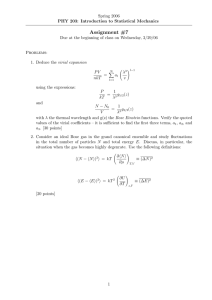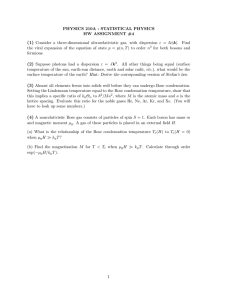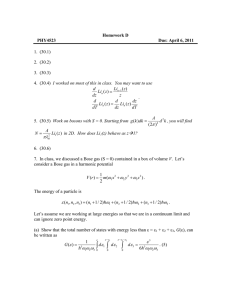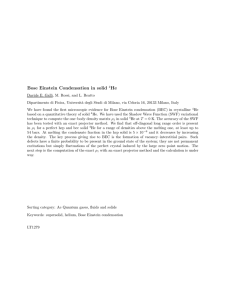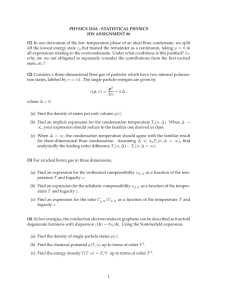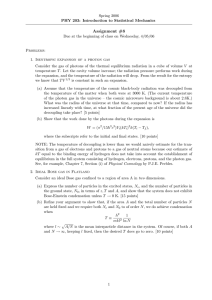BOOSTED SPECTRAL EMBEDDING (BOSE): APPLICATIONS TO CONTENT-BASED IMAGE RETRIEVAL OF HISTOPATHOLOGY
advertisement
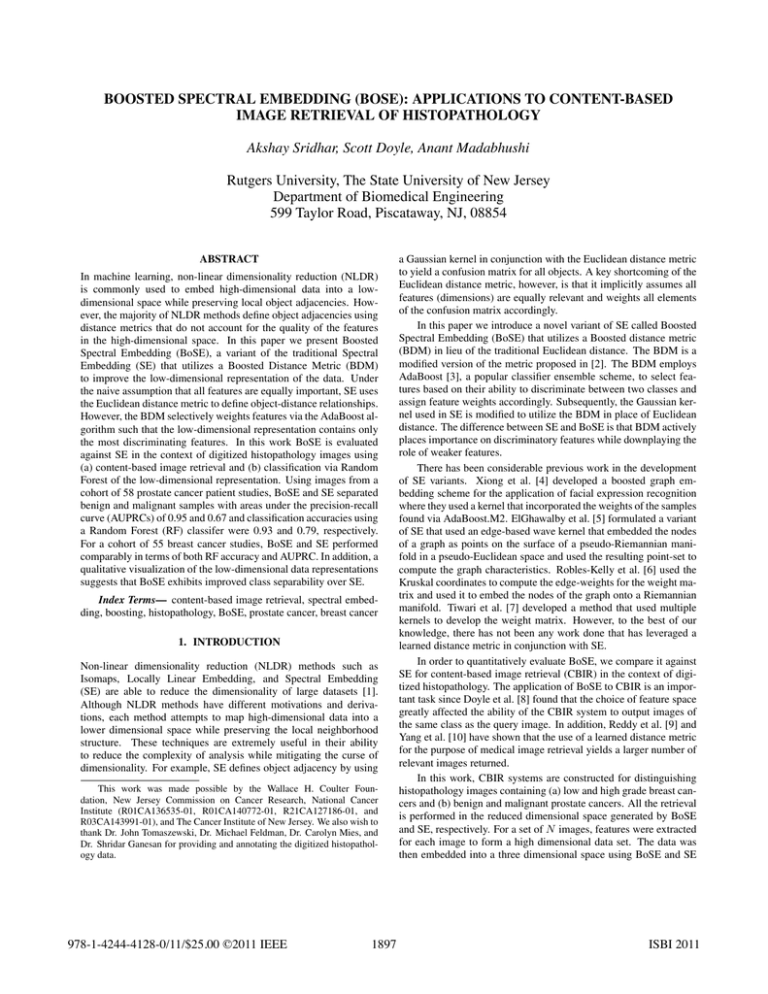
BOOSTED SPECTRAL EMBEDDING (BOSE): APPLICATIONS TO CONTENT-BASED
IMAGE RETRIEVAL OF HISTOPATHOLOGY
Akshay Sridhar, Scott Doyle, Anant Madabhushi
Rutgers University, The State University of New Jersey
Department of Biomedical Engineering
599 Taylor Road, Piscataway, NJ, 08854
ABSTRACT
In machine learning, non-linear dimensionality reduction (NLDR)
is commonly used to embed high-dimensional data into a lowdimensional space while preserving local object adjacencies. However, the majority of NLDR methods define object adjacencies using
distance metrics that do not account for the quality of the features
in the high-dimensional space. In this paper we present Boosted
Spectral Embedding (BoSE), a variant of the traditional Spectral
Embedding (SE) that utilizes a Boosted Distance Metric (BDM)
to improve the low-dimensional representation of the data. Under
the naive assumption that all features are equally important, SE uses
the Euclidean distance metric to define object-distance relationships.
However, the BDM selectively weights features via the AdaBoost algorithm such that the low-dimensional representation contains only
the most discriminating features. In this work BoSE is evaluated
against SE in the context of digitized histopathology images using
(a) content-based image retrieval and (b) classification via Random
Forest of the low-dimensional representation. Using images from a
cohort of 58 prostate cancer patient studies, BoSE and SE separated
benign and malignant samples with areas under the precision-recall
curve (AUPRCs) of 0.95 and 0.67 and classification accuracies using
a Random Forest (RF) classifer were 0.93 and 0.79, respectively.
For a cohort of 55 breast cancer studies, BoSE and SE performed
comparably in terms of both RF accuracy and AUPRC. In addition, a
qualitative visualization of the low-dimensional data representations
suggests that BoSE exhibits improved class separability over SE.
Index Terms— content-based image retrieval, spectral embedding, boosting, histopathology, BoSE, prostate cancer, breast cancer
1. INTRODUCTION
Non-linear dimensionality reduction (NLDR) methods such as
Isomaps, Locally Linear Embedding, and Spectral Embedding
(SE) are able to reduce the dimensionality of large datasets [1].
Although NLDR methods have different motivations and derivations, each method attempts to map high-dimensional data into a
lower dimensional space while preserving the local neighborhood
structure. These techniques are extremely useful in their ability
to reduce the complexity of analysis while mitigating the curse of
dimensionality. For example, SE defines object adjacency by using
This work was made possible by the Wallace H. Coulter Foundation, New Jersey Commission on Cancer Research, National Cancer
Institute (R01CA136535-01, R01CA140772-01, R21CA127186-01, and
R03CA143991-01), and The Cancer Institute of New Jersey. We also wish to
thank Dr. John Tomaszewski, Dr. Michael Feldman, Dr. Carolyn Mies, and
Dr. Shridar Ganesan for providing and annotating the digitized histopathology data.
978-1-4244-4128-0/11/$25.00 ©2011 IEEE
1897
a Gaussian kernel in conjunction with the Euclidean distance metric
to yield a confusion matrix for all objects. A key shortcoming of the
Euclidean distance metric, however, is that it implicitly assumes all
features (dimensions) are equally relevant and weights all elements
of the confusion matrix accordingly.
In this paper we introduce a novel variant of SE called Boosted
Spectral Embedding (BoSE) that utilizes a Boosted distance metric
(BDM) in lieu of the traditional Euclidean distance. The BDM is a
modified version of the metric proposed in [2]. The BDM employs
AdaBoost [3], a popular classifier ensemble scheme, to select features based on their ability to discriminate between two classes and
assign feature weights accordingly. Subsequently, the Gaussian kernel used in SE is modified to utilize the BDM in place of Euclidean
distance. The difference between SE and BoSE is that BDM actively
places importance on discriminatory features while downplaying the
role of weaker features.
There has been considerable previous work in the development
of SE variants. Xiong et al. [4] developed a boosted graph embedding scheme for the application of facial expression recognition
where they used a kernel that incorporated the weights of the samples
found via AdaBoost.M2. ElGhawalby et al. [5] formulated a variant
of SE that used an edge-based wave kernel that embedded the nodes
of a graph as points on the surface of a pseudo-Riemannian manifold in a pseudo-Euclidean space and used the resulting point-set to
compute the graph characteristics. Robles-Kelly et al. [6] used the
Kruskal coordinates to compute the edge-weights for the weight matrix and used it to embed the nodes of the graph onto a Riemannian
manifold. Tiwari et al. [7] developed a method that used multiple
kernels to develop the weight matrix. However, to the best of our
knowledge, there has not been any work done that has leveraged a
learned distance metric in conjunction with SE.
In order to quantitatively evaluate BoSE, we compare it against
SE for content-based image retrieval (CBIR) in the context of digitized histopathology. The application of BoSE to CBIR is an important task since Doyle et al. [8] found that the choice of feature space
greatly affected the ability of the CBIR system to output images of
the same class as the query image. In addition, Reddy et al. [9] and
Yang et al. [10] have shown that the use of a learned distance metric
for the purpose of medical image retrieval yields a larger number of
relevant images returned.
In this work, CBIR systems are constructed for distinguishing
histopathology images containing (a) low and high grade breast cancers and (b) benign and malignant prostate cancers. All the retrieval
is performed in the reduced dimensional space generated by BoSE
and SE, respectively. For a set of N images, features were extracted
for each image to form a high dimensional data set. The data was
then embedded into a three dimensional space using BoSE and SE
ISBI 2011
to create the manifolds MBOSE and MSE . Each of the N images
is successively treated as the query image and the closest images on
MBOSE and MSE are then retrieved. Precision recall (PR) curves
are then generated for each of BoSE and SE and the corresponding
areas under the PR curves are compared, larger area signifying improved performance. A second performance measure for evaluating
BoSE and SE is via classifier accuracy. In this work a Random Forest (RF) classifier (obtained by Bagging decision trees) was trained
on both MBOSE and MSE . The accuracy of the RF classifier should
reflect the quality of MBOSE and MSE and hence the class discriminability offered by the BoSE and SE schemes, respectively.
The primary contributions of this work are:
3.1. Construction of Weak Classifiers
Step 1: Extract quantitative features [2] from all xi ∈ R1×D .
Step 2: Create training set Xtr ∈ X containing N objects by randomly sampling half of entire dataset X.
Step 3: Let Φd (X) denote the vector containing the values of fea−
ture d ∈ {1, 2, · · · , D}. Φ+
d (X) and Φd (X) are the feature
values from the positive and negative class respectively. Obtain probability distribution functions for both Bd+ and Bd− by
solving,
p(Φd (X), ωa ) = Φτd −1 (X)
exp( −Φdη(X) )
(2)
• The construction of a novel kernel representation for SE
that uses Boosting [3] to identify which individual features
should be used for embedding high-dimensional data into a
low-dimensional space.
where Γ is the gamma function that is parameterized by a
scale parameter τ and a shape parameter η with τ, η > 0.
• A reduced dimensional manifold representation that yields
greater class discriminability compared to the traditional SE
scheme.
Step 4: Obtain the a posteriori probability P (ω1 |Φd (X)) which
computes the likelihood that an object with feature value Φd
belongs to the positive class ω1 by solving,
• In conjunction with BoSE, the construction of a CBIR system
that is employed for digital histopathology.
The rest of the paper is organized as follows. The formulations
for SE and BDM are presented in Sections 2 and 3, respectively. The
theory and formulation for BoSE is presented in Section 4 and the
application of BoSE to CBIR is presented in Section 5. The experimental results and discussion are presented in Section 6. Lastly,
concluding remarks are presented in Section 7.
2. SPECTRAL EMBEDDING FORMULATION
Let X = {x1 , x2 , · · · , xN } ∈ RN ×D where X contains N objects
with D dimensions. The goal of SE is to project the feature vectors from a D dimensional space on to a k dimensional space where
k << D. Let Y = {y1 , y2 , · · · , yN } ∈ RN ×k where Y is the low
dimensional projection of X. The eigenvector yi associated with
object i ∈ {1, 2, · · · , N } is defined as
y = argmin
y
N
yi − yj 2 wij ,
(1)
i,j=1
where wij = exp(−xi − xj 2 /σ) is the (i, j) element of the
weight matrix W ∈ RN ×N that assigns edge weights to characterize pairwise similarities between objects xi and xj for i, j ∈
{1, 2, · · · , N }. The constant σ is used as a scaling parameter. The
minimization of Equation (1) reduces to an eigenvalue decomposition problem,
(L − W)y = λLy, where L is the diagonal matrix,
Lii = i wij .
3. BOOSTED DISTANCE METRIC
Let Φd (xi ) for d ∈ {1, 2, · · · , D} represent the value of feature
d from xi . Let L(xi ) ∈ {ω1 , ω2 } represent the ground truth label
denoting positive or negative class, respectively. The BDM is constructed in three main steps. First, for each d, we construct a weak
Bayesian classifier hd (Φ(xi )) ∈ {ω1 , ω2 }, d ∈ {1, 2, · · · , D} to
perform class prediction for xi . Next, the T most accurate classifiers ht , t ∈ {1, 2, · · · , T } are identified and weights associated
with each ht are learned via AdaBoost [3]. The BDM is then defined using the features Φt and associated weights αt .
1898
η τ Γ(τ )
P (ω1 )p(Φd (X)|ω1 )
P (ω1 |Φd (X)) = a P (ωa )p(Φd (X)|ωa )
(3)
3.2. Learning Feature Weights via AdaBoost
We use the AdaBoost algorithm [3] to select the weak classifiers
that are best able to distinguish between the positive and negative
classes. AdaBoost works in an iterative fashion by choosing the bestperforming weak classifiers and assigning weights based on the classification accuracy of that feature. All samples are initialized with
equal weights. At each iteration, weights increase for samples that
are difficult to classify. This ensures that subsequent weak classifiers
focus on these samples. The output of the algorithm is a set of weak
classifiers hg and their associated weights αg , g ∈ {1, 2, · · · , G}
where 1 ≤ G ≤ D and αg > 0.
3.3. Constructing the BDM
The BDM is constructed after the weights and features have been
chosen. To find the distance between two points in the high dimensional space, we calculate,
DBDM (xi , xj ) =
G
αg (Φg (xi ) − Φg (xj ))
2
12
(4)
g=1
1
G
2 2
Proposition: Given that DEu =
is
g=1 (Φg (xi ) − Φg (xj ))
the Euclidean distance metric, DBDM is also a distance metric.
DEu satisfies the following properties: (1) it is positive, (2) it is
symmetric, (3) it is definite, (4) the triangle inequality holds. DBDM
must also be a metric since αg ∈ R+ is positive and real valued.
Therefore properties (1)-(4) are satisfied for DBDM .
4. BOOSTED SPECTRAL EMBEDDING (BOSE)
The Boosted Spectral Embedding (BoSE) is a variant of SE where
the computation of the confusion matrix W is defined as,
D
BDM (xi , xj )
.
wij = exp −
σ
(5)
Data
Breast
Prostate
Classes (ω1 /ω2 )
High Grade/Low Grade
Cancer/Benign
Features
Haralick
Gabor, Haralick, first-order statistics
Class Distribution (ω1 /ω2 )
36/19
29/29
Table 1. List of the breast cancer and prostate cancer datasets used in this study.
Since DBDM is a metric, W is positive, semi-definite, and symmetric.
The idea behind using the BDM to define W is to place importance
on features that are good at discriminating between objects of different classes. This results in a final embedding that contains greater
separation between objects from different classes as compared to the
Euclidean distance.
5. EVALUATION OF BOSE USING CBIR AND CLASSIFIER
ACCURACY
5.1. BoSE for Content-Based Image Retrieval
Algorithm: BoSE
Input: Training samples S tr , Testing samples S te , L{S tr }, L{S te },
iterations G
Output: Lower dimensional embedding Y
begin
1: Build weak classifiers hd : d ∈ {1, 2, · · · , D} via a Bayesian
Classifier;
2: Select optimal weak classifiers hg and weights αg for g ∈
{1, 2, · · · , G} via AdaBoost;
3: Obtain BDM by applying Equation 4;
4: Obtain W by Equation 5;
5: Find Y ∈ RN ×k by Equation 1;
6: Output Y.
end
5.2. Precision Recall Curves
The performance of a CBIR system is determined by how many retrieved images for a given query image are relevant to the query,
defined as images which belong to the same class as the query image, and also the order in which they appear. Precision is defined
, where ξ(β) denotes the number of relevant objects
as ρ(β) = ξ(β)
β
in the β closest objects. Euclidean distance within an embedding
ξ(β)
. Precidefines object adjacency. Recall is defined as r(β) = ξ(N
)
sion recall curves were generated by plotting ρ(β) versus r(β) for
β ∈ {1, 2, · · · , N }. Area under the precision recall curve (AUPRC)
was measured and used to evaluate the CBIR system.
5.3. Classifier Accuracy
The discriminability of the reduced dimensional manifolds MBOSE
and MSE (Figure 1) is evaluated directly via a Random Forest (RF)
classifier. A RF classifier is an ensemble of decision trees (i.e. weak
learners) combined via bootstrap aggregation. By averaging decisions across the weak classifiers, a strong classifier that reduces overall bias and variance is created.
A randomized, 3-fold cross-validation scheme was used to determine training and testing inputs for the RF classifier. First, the entire
dataset is randomly divided into three equally-sized subsets. Two
of the subsets are used for training the RF classifier, which is then
evaluated on the remaining subset. The subsets are subsequently rotated until each subset is used for evaluation exactly once. The entire
1899
cross-validation scheme is repeated over 50 iterations, over which
mean and standard deviation classification accuracy are reported.
6. EXPERIMENTAL DESIGN AND RESULTS
6.1. Dataset Description
For this paper we considered two datasets comprising (1) 55 breast
and (2) 58 prostate biopsy tissue samples, respectively (Table 1).
Slides from both datasets were stained with hematoxylin and eosin
(H&E) and scanned into a computer via a whole-slide digital scanner
at the University of Pennsylvania. Ground truth annotations were delineated by an expert pathologist for all data and Bloom-Richardson
(BR) grades accompanied all breast cancer data.
6.2. Experiment 1: Distinguishing Malignant from Benign
Prostate Histopathology
Due to the large volume of prostate cancer biopsy samples, manual
inspection is a time-consuming and labor-intensive process. Hence
the automated detection of malignant from benign tissue on prostate
biopsy samples is an important task. The objective of this experiment was to distinguish between malignant and benign prostate tissue patches (Table 1) from biopsy samples obtained from 55 patients.
From each image, 14 texture features (Gabor, Haralick, first-order
statistics) were extracted from each image [8] and Adaboost identified and weighted the top 4 performing features. AUPRC for CBIR
with embeddings generated by BoSE (CBIR-BoSE) was 0.95±0.01
(Table 2). AUPRC for CBIR with embeddings generated by SE
(CBIR-SE) was 0.67±0.13. Figure 2(a) displays the precision recall
curves for CBIR-BoSE and CBIR-SE demonstrating CBIR-BoSE
performs considerably better than CBIR-SE. Figures 1(a) and 1(b)
displays the embeddings for BoSE and SE, respectively, showing a
much greater separation between the malignant and benign classes
in the low-dimensional embedding plots created by BoSE compared
to SE.
Data
Prostate Cancer
Detection
Breast Cancer
Grading
Method
BoSE
SE
BoSE
SE
AUPRC
0.95 ± 0.01
0.67 ± 0.13
0.88 ± 0.02
0.88 ± 0.02
RF Accuracy
0.93 ± 0.01
0.79 ± 0.01
0.98 ± 0.01
0.98 ± 0.02
Table 2. Quantitative results for Boosted Spectral Embedding
(BoSE) and traditional Spectral Embedding (SE) are presented for
both the breast and prostate cancer datasets. For all experiments,
embedding performance was measured via (1) area under the precision recall curve (AUPRC) and (2) cross-validation accuracy of a
Random Forest (RF) classifier shown.
6.3. Experiment 2: Distinguishing High from Low Grade Breast
Histopathology
Manual grading of breast cancer suffers from high inter- and intrapathologist variability. Hence the automated grading of breast cancer
−3
−3
x 10
x 10
−6
2
x 10
1.5
4
1
Malignant
Benign
0.5
1
Malignant
Benign
2
0
−1
−2
−2
0.5
−1
6
0
1
−4
3
4
−3
−6
x 10
1
0
−0.5
x 10
High Grade
Low Grade
0
−3
x 10
1
2
−6
0
x 10
0
−2
−0.5
−1
−1.5
−1
1
0.5
0
−0.5
0.5
2
−2
−3
−3
x 10
−3
(a)
0
−1
−2
1
−1
(b)
−5
5
0
15
10
−6
x 10
4
2
0
0.5
−0.5
−6
x 10
6
High Grade
Low Grade
−1
1
0
2
−2
0
−4
−0.5
−4
−1
x 10
(c)
−7
x 10
−6
(d)
Fig. 1. Low-dimensional embedding plots are shown illustrating (a), (b) prostate and (c), (d) breast cancer histopathology images using (a),
(c) BoSE and (b), (d) SE methods. It is clear from visual inspection that the embeddings produced by BoSE yield better class separation as
compared to SE.
histopathology could potentially enable the creation of a quantitative, reproducible measure of tumor malignancy. To define a twoclass problem, all images are first separated into either low (BR 4,
5) and high (BR 7, 8) grade classes (Table 1). From each image, 50
Haralick features [8] are extracted to describe textural patterns. Adaboost identified and weighted 12 optimal features. CBIR-BoSE had
an AUPRC of 0.88±0.02 compared to CBIR-SE yielded an AUPRC
of 0.88 ± 0.02 (Table 2). The intersection of the PR curves shown
in Figure 2(b) indicates that they have the same performance at that
point. Overall, however, CBIR-BoSE outperforms CBIR-SE. The
embedding produced by BoSE (Figure 1(c)) shows improved separation between the low and high grade classes over the embedding
produced by SE (Figure 1(d)). While no differences were observed
between the AUPRC and the classifier accuracy values for the SE
and BoSE scheme, in this application, the lower dimensional embedding representations (Figures 1(c),(d)) appear to suggest better class
separability between the two classes in the BoSE space compared to
SE.
[1] G. Lee et al., “Investigating the efficacy of nonlinear dimensionality reduction schemes in classifying gene and protein expression studies,” IEEE Trans. CBIB, vol. 5, pp. 368–384,
2008.
[2] J. Naik et al., “A boosted distance metric: application to
content based image retrieval and classification of digitized
histopathology,” in SPIE Medical Imaging, 2009.
0.9
0.9
[3] Y. Freund and R.E. Schapire, “A decision-theoretic generalization of on-line learning and an application to boosting,” JCSS:
Journal of Computer and System Sciences, vol. 55, pp. 119–
139, 1997.
0.8
Precision
0.8
Precision
8. REFERENCES
1
1
0.7
0.7
0.6
0.6
CBIR−SE (AUC = 0.67)
CBIR−BoSE (AUC = 0.95)
0.5
0.4
scheme, which uses the Euclidean distance metric to define object
similarity. Quantitative results showed that BoSE had a higher
AUPRC and classification accuracy compared to SE for retrieving
benign or malignant prostate histopathology images. For breast
cancer grading, BoSE achieved identical results (via AUPRC and
classification accuracy measures) to SE. This may have been due
to the fact that the features used for BoSE and SE for this dataset
were highly discriminating to begin with. The reduced dimensional
embedding for this dataset, however, appeared to show greater class
discriminability for BoSE compared to SE.
0
0.1
0.2
0.3
0.4
0.5
Recall
0.6
CBIR−BoSE (AUC = 0.88)
CBIR−SE (AUC = 0.88)
0.5
0.7
0.8
0.9
1
0.4
0
0.1
0.2
0.3
(a)
0.4
0.5
Recall
0.6
0.7
0.8
0.9
[4] L. Xiong et al., “Boosting graph embedding with application
to facial expression recognition,” in IAS, 2009, pp. 707–710.
1
(b)
[5] H. ElGhawalby et al., “Graph embedding using an edge-based
wave kernel.,” in SSPR/SPR, 2010, pp. 60–69.
Fig. 2. Precision-recall curves for (a) prostate and (b) breast
histopathology datasets. Note that while similar AUPRC values were
obtained for the breast cancer dataset for the BoSE and SE schemes,
significant improvement was observed for the BoSE scheme for the
prostate dataset.
[6] A. Robles-Kelly et al., “A riemannian approach to graph embedding,” Pattern Recognition, vol. 40, pp. 1042–1056, 2007.
[7] P. Tiwari et al., “Semi supervised multi kernel (sesmik) graph
embedding: Identifying aggressive prostate cancer via magnetic resonance imaging and spectroscopy,” in MICCAI, 2010,
pp. 666–673.
7. CONCLUDING REMARKS
In this paper, we presented Boosted Spectral Embedding (BoSE),
which modifies the traditional Spectral Embedding (SE) to use the
improved Boosted Distance Metric (BDM). The BDM preferentially weights features that discriminate between objects of different
classes allowing for a confusion matrix which better describes object similarity. By altering the confusion matrix BoSE yields an
embedding with improved separation between objects of differing classes. We compared BoSE to the Spectral Embedding (SE)
[8] S. Doyle et al., “Using manifold learning for content-based
image retrieval of prostate histopathology,” in MICCAI, 2007,
pp. 53–62.
[9] C.K. Reddy et al., “Retrieval and ranking of biomedical images
using boosted haar features,” in BIBE, 2008, pp. 1–6.
[10] L. Yang et al., “A boosting framework for visuality-preserving
distance metric learning and its application to medical image
retrieval,” IEEE PAMI, vol. 32, pp. 30–44, 2010.
1900
